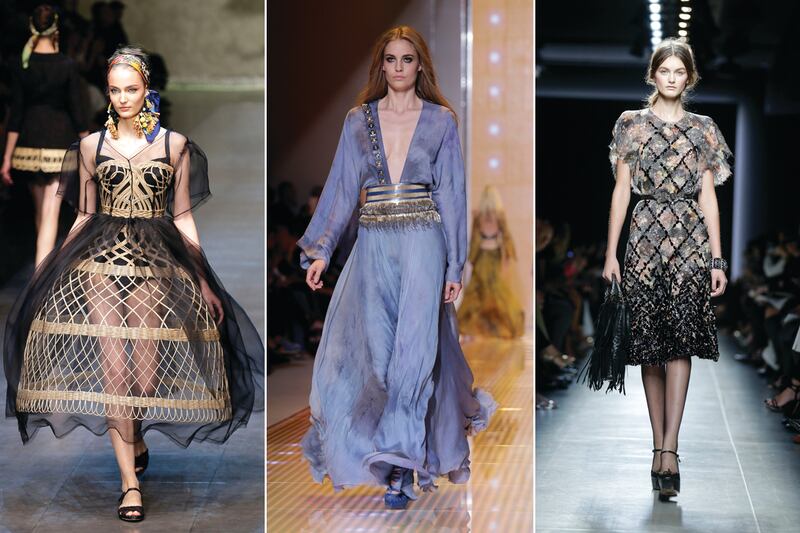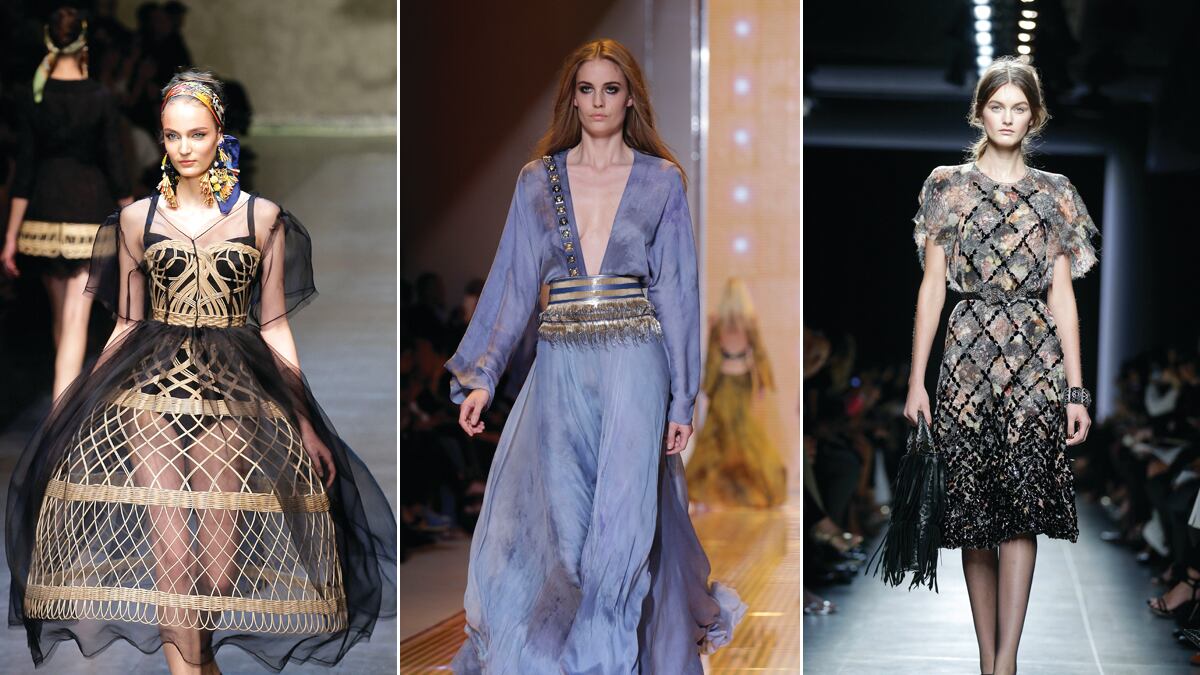
How lovely it would be to live in a world as imagined by fashion designers. For spring 2013, they have not been cowed by sluggish economies. They aren’t feeling blue from all the death and violence that racks the Middle East and North Africa. They are not fretful about global warming, West Nile virus, or any of the various and chronic existential pains that come from living in these turbulent times.
Designers in Milan have adhered to one of the fundamental goals of the creative class, which is to help us find solace and joy in the beauty that surrounds us—whether in a museum or at the mall. Without regard to politics or political correctness, they have been plain and honest about pleasure, fond memories, and illogical delights.
At Dolce & Gabbana on Sunday afternoon, a spare stage surrounded by troughs of dripping greenery and paddle-shaped succulents served as a backdrop for a loving homage to Sicily. Their spring 2013 collection was a stirring, silly, dizzying parade of kaleidoscopic patterns, wry uses of materials such as raffia, luxurious embroidery, and evocative prints. It was a pleasantly lush Dolce & Gabbana romp filled with shaped dresses, circle skirts, and bloomers.
The prints were inspired by characters that populate Sicilian street fairs and puppetry stages. They are figures rooted in traditions—funny, personally meaningful, and not especially politically correct. Full skirts, slender dresses, and tunic tops were stitched from fading Moorish-looking prints depicting lemon-lipped blacks and mustachioed knights on horseback. Images of lemon trees adorned blouses. And skirts dazzled the eyes with patterns borrowed from traditional ceramics.
There was nothing ponderous or political about this collection—no matter how gut-clenchingly odd it might be to see a kind of Golliwogg face on a designer shirt worn by a white model.
In the 1980s African-American designer Patrick Kelly tried to reappropriate that bug-eyed, thick-lipped image by incorporating it into his work. The Mississippi-born designer tried to defuse it of its freight of derisiveness and racism, while not forgetting its distinctly American history. The Golliwogg is not fully freed of its burden. But it is thought-provoking to see it in the context of another culture’s sweet memories—a reminder that our world is both vast and tiny, as well as exceedingly complex.
Designers regularly throw colors, shapes, ethnicity, and bits of cultural history into an enormous pot, often with jarring results. But oftentimes they forget the essential ingredients: joy and a bit of their own personal story. In the case of Domenico Dolce and Stefano Gabbana, for about 15 minutes on their runway, politics, history, and stressing reality were crowded out. And in their place was an ode to the designers’ past, a remembrance of their youth, and a strong argument for how one man’s sorrow can just as righteously be another man’s joy.
Milan has been awash with aesthetic uppers such as floral prints, sun-drenched colors, and easy shapes. At Versace, the best elements were tie-dyed prints in blue with a signature Medusa seemingly floating amid a summer sky. But the collection’s use of lingerie lace seemed a rather tarty distraction, and the free-floating chiffon gowns had the feel of vernal equinox tree-hugging costumes. You could almost smell the patchouli.
Versus was filled with appropriate rock-and-roll spirit—emphasized by the runway show’s live soundtrack by Gossip’s Beth Ditto. Trim jackets and short skirts in fiery red and spliced with zippers were expertly cut for a night owl.
And at Marni, Consuelo Castiglioni chose silhouettes that only skimmed the body, rarely ever revealing the curve of a hip or the roundness of the breasts. The tent-shaped silhouette was cut from sculptural fabrics to create a pleasantly relaxed but clean aesthetic. Chrysanthemum prints in orange or purple brightened a fairly quiet palette, and judicious sprinkles of glitter served as a reminder of the eccentric femininity on which Marni has built its reputation.
The work of the design team at Aquilano Rimondi was jubilant, emotional, and beautiful. Inspired by the work of Picasso and classic Italian comedies, the collection of sculptural skirts and hourglass-shaped tunics was also a magnificent display of architectural vision. The rich colors—like something removed from a stained-glass window—were vivid and magnetic. The intricate beading in graphic harlequin patterns gave the garments a sense of grandeur and importance.
There is showmanship here, but it is less about braggadocio than a revelation of all the possibilities now available to designers and their customers. Fashion is not art, not in the sense that the product’s pure beauty or emotional dexterity allows it to rise above practicality. But designers Roberto Rimondi and Tommaso Aquilano manage to draw a link between these worlds in a way that reminds you that there is no shame in the pure pleasure that can be found in a beautiful dress. It can lift the spirits as much as any series of brush strokes or melodic chords.
And finally, it’s hard to find deep meaning in the gently blurred yellow tulips printed on a belted coat and matching dress from Bottega Veneta. There is nothing especially profound in a mocha-colored dress with a graphic print of daisies that has been splashed with jet beads. But there is plenty of exquisite technique and dreamy artistry over which to marvel.
Designer Tomas Maier’s Saturday-morning presentation, which started in a pleasingly civilized manner with a bit of coffee and fruit juice, was a calm reiteration of his skill. There was nothing flamboyant about his work. But if you leaned in close, you could see the tiny raw edges of a delicate seam, the wash of gemstones around a neckline, and the easy movement of a hem.
Maier is a master at creating grown-up clothes that make women look pretty and sophisticated and, of course, well-to-do. He has always said that he designs for a woman who is confident enough to shun visible labels and logos. She doesn’t need them to validate her sense of style. And indeed, there is nothing that announces the Bottega Veneta brand from 50 paces. But Maier also designs for a woman who is not racked by intellectual angst regarding her place in the world, the role of femininity, or the politics of gender. She is blissfully well adjusted and straightforward. And she likes a pretty dress.
And at a time when everything—big global issues as well as small neighborhood concerns—seems terribly fraught, this sort of functional woman, this sort of cleareyed designer should be celebrated.
It takes confidence to be willing to refrain from bold gestures and to tell one’s aesthetic story with subtlety and finesse. But a customer can tell when she’s in the hands of a strong-minded, but gracious, designer. And when that happens, it’s one less thing to worry about in a terribly worrisome world.






